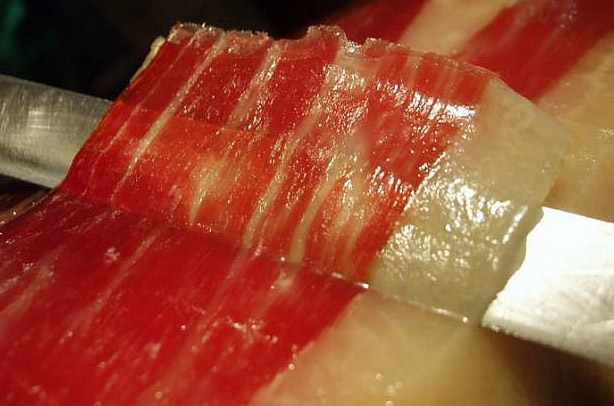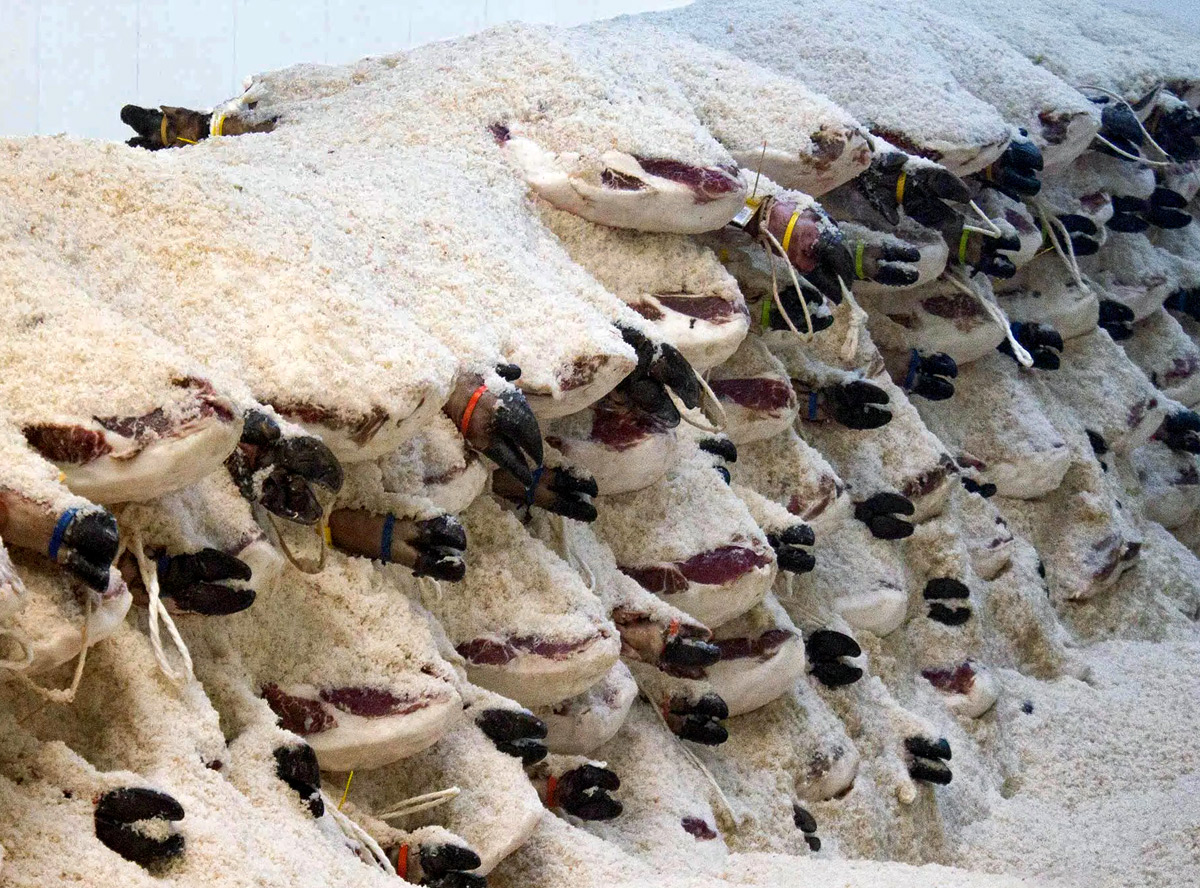Here are some questions that consumers ask when making their choice. The benchmark product is the ham and these answers mainly deal with this type of cured meat, but are applicable to other pieces.
THE IBERIAN PIG - ITS PECULIARITIES
Serrano ham VS Iberian ham
Do not be fooled, a serrano ham simply designates a ham from the Spanish Sierra (mountain). It does not carry any notion of origin or of breed. Hams which are called serranos can also come from non-Iberian pigs. This is one of the essential criteria that must be taken into account when purchasing. Intensively-bred white pigs may carry the "Serrano" tag, but this is not an indication of quality.
Iberian ham implies a notion of breed and purity, of pedigree. Made from black pigs, the best, which, since the 2014 standard, are called Pata Negra. It is a particular breed, which has physical characteristics totally different from other breeds: short fur, dark skin, thin legs, long snout and ears, etc.
And the Pata Negra?
Since 2014, a pig that is not 100% Iberian (genetically 100% pure Iberian breed) cannot be called Pata Negra. Note: there are other black pigs which are not Iberian pigs (the black pigs of Bigorre and Corsica, for example).
Are all Spanish denominations made from Iberian pigs?
Ideally, yes, but realistically: no. There are only four DOs Denominación de Origen that control the production of the Iberian pig:
- D.O. Jamón de Huelva in Andalusia
- D.O. Guijuelo near Salamanca
- D.O. Dehesa de Extremadura (between Portugal and Andalusia)
- D.O. Jamón Los Pedroches (near Cordoba)
For non-Iberian breeds, the Spanish Ministry of Agriculture recognizes 3 main areas: D.O. Jamón de Teruel, Denominación específica Jamón de Trevélez (to the south of the Sierra Nevada) and Denominación de calidad jamón Riojano.
LA BELLOTA - ACORNS
Do Iberian pigs feed exclusively on acorns?
No. In reality, the pig naturally feeds on herbs, fruits, and small insects or reptiles found in the pasture (dehesa) and its diet is not composed solely of acorns, for the simple reason that acorns are not available all year round. In addition, from birth and throughout its growth, the pig needs another element in its diet (fodder, vegetables, cereals, etc). It is from autumn, at the time of the montanera, when the pigs rout under the oaks in the dehesa.
Not all pigs have the same diet, as there are not enough acorns for all the pigs. In fact, depending on the producers, it takes one hectare of oaks for each pig.
Which is the best Iberian ham?
In Spain, the best ham is the 100% Iberian bellota ham. There are 4 categories/labels:
- black, for pigs of 100% Iberian breed, fed on acorns, raised in the wild.
- red, for pigs reared on acorns but of 50-75% Iberian breed.
- green, for free-range pigs in the dehesa, fed on forage, cereals and legumes
- white, for pigs raised on a farm and fed on fodder, cereals and legumes

How do I recognise an acorn ham?
It isn't easy, since there are many fakes. Depending on the curing time, the external colour of a piece tends to turn black, and this may cause confusion. While it is easier to tell from the inside of a piece, this isn't always possible. The safest way is to look at the label, since it contains all the information about the product (producer, quality, provenance, etc.).
The white spots should also be taken into account. They are sometimes scattered over the flesh, which are associated with the slow curing and maturation process of the leg. The degradation of the proteins present in the meat causes the formation of these small crystals of amino acids, called tyrosine. The presence of these white crystals is generally indicative of higher quality.
ABOUT HAM
How much does an Iberian ham weigh?
The weight of a ham varies between 6.5 and 9 kilos, and can be too fatty, too dry, etc. The ideal weight is between 7.5 and 8 kilos. After the important curing phase, (generally a minimum of 3 years for Acorn hams), its weight is greatly reduced.
What is the edible part, which can be cut?
About 40- 50% of an Iberian ham is wasted. This is more than for white pigs. The waste is essentially the bone, the fat (tocino), its rind, and obviously the hoof.
For paletas, this percentage rises to 50 - 60%. For example, approximately 2 kilos of slices can be taken from a paleta of 4.5kg.
CURING, STORING AND TASTING HAM
How long is the curing time?
The duration varies according to the weight and size of the ham or the paleta. A large acorn ham (10 kg) can have a curing process of 4 or 5 years.
On average, the hams remain in the cellars for around 36 months and the paletas about 24 months. The ventilation and temperature of the places also plays a role. This is what makes the Huelva appellation the most recognised, since it is not too cold in winter, and the summer heat is attenuated by the wind blowing in from the Atlantic in the south.
How do I store the ham once a cut has been taken?
Once the ham is opened, it should be kept in a cool, dry place. It is recommended that you cover the cut part with the fat rind, which prevents it from drying.
How to cut a ham?
It is useful to have one or more sharp knives around. The process can also be helped by a support that holds the ham while it is being cut, but it is not essential (the butcher shop of Encarnación market does not use one, for example). Start by cutting the rind, then the first layer of fat.There are numerous videos that explain in more detail, but remember that in Spain the slices are cut are thin and small, about 5x5 mm. The slices should be almost transparent.
Some informations about the dehesa
The "dehesa" is the Iberian pigs' natural habitat. It is a pasture area composed mainly of cork and holm oaks, where it begins to rout when its weight reaches approximately 80-100 kilos. During this period, the acorn forms the basis of their food and gives the unique flavour to Pata Negra hams.
The composition of the acorn varies considerably from one oak to another and depends on the time of year. However, the seeds of the holm oak are generally considered to be the sweetest.
In Andalusia, the dehesa covers around 1.2 million hectares, mainly distributed along the Sierra Morena, and to a lesser extent the Sierra de Cádiz and the Sierra de Málaga.
The holm oak is a species of tree that retains its leaves for 3 to 4 years on average. It flowers between April and May and produces fruits in the months of October and November.
The cork oak, whose acorns mature between September and February.
The "montanera" is the period during which the pig is fed mostly acorns found in the dehesa. During this fattening phase, the pig can consume around 10 kilos of acorns a day. The montanera lasts from four to five months (from December to April, approximately) according to the acorn season.
The "descorchadores" are the people in charge of removing the cork layer from the cork oaks. In this way the dehesa is revitalised, and the acorn harvest is more abundant in the years when the cork is removed, more or less every 9 years (affecting the fattening of the pigs and the quality of their hams). An important part of this cork is destined to bottle stoppers, which give quality to those wines that pair perfectly with the ham.
The acorn is the Iberian pig's food par excellence, being exclusive to it, as it is the only animal that has the ability and intelligence to peel, discard and not eat the skin. It contains tannins, which are very unpalatable. Humans also get some benefit from acorns, especially those of holm oaks, as they are sweeter than those of the "chaparros" cork oaks, which are usually bitter. In the post-war years, the years of the "famine", when all kinds of foodstuffs were scarce, coffee being one of them, the rural population used to prepare "buche de café" with roasted and ground acorns. Some army barracks even prepared it for the troops. Recently, an Andalusian company have marketed acorn milk as a great novelty.
The Salting of Iberian Ham
After the necessary days spent in salt, the ham continues its process while maintaining the traditional method used since time immemorial, in order to achieve optimal curing. In fact, this method was inspired by Nature itself, since it was the natural cycles of the seasons that guided the process, resulting in a product that, centuries later, has become a global gastronomic treasure.
WINTER
Salting:
The salting time varies depending on the weight of the piece, at a rate of approximately one day per kilo of ham. During this stage, the salt penetrates the muscle tissue. Once salting is complete, the pieces are washed in warm water to remove the adhering salt. After washing, each ham is shaped one by one (a process called alimonado or embolado).

Post-salting or resting:
This is a preliminary phase before curing, during which the homogeneous distribution of salt takes place, both on the surface and inside the ham. In this stage, the pieces are hung for at least 40 days.
SPRING
Ham drying:
At this stage, the ham continues its dehydration process, accompanied by proteolysis and lipolysis phenomena that will influence its aroma and flavor. The temperature gradually increases while relative humidity decreases. As the temperature rises, the fat melts and infiltrates the muscle tissue: this is one of the typical characteristics of ham.
SUMMER
Curing:
This corresponds to the summer months. During this period, at the hottest times, the exudation of the hams becomes much more intense and the dripping of fat more pronounced. This phase lasts about three months, favoring the reactions that give Iberian ham its unique and incomparable texture, aroma, and flavor.
AUTUMN
Aging or maturation:
After leaving the drying rooms, the pieces are classified according to their weight, quality, and shape, and then transferred to natural cellars to reach the final stage of curing. Hams are usually moved to the cellars in autumn, when the temperature begins to drop. The duration of this stage in the cellar is highly variable, depending on the degree of weight loss and aroma required for each piece. It is at this point that the role of the master ham maker becomes essential: he decides the right moment.
See also
 fr
fr en
en es
es